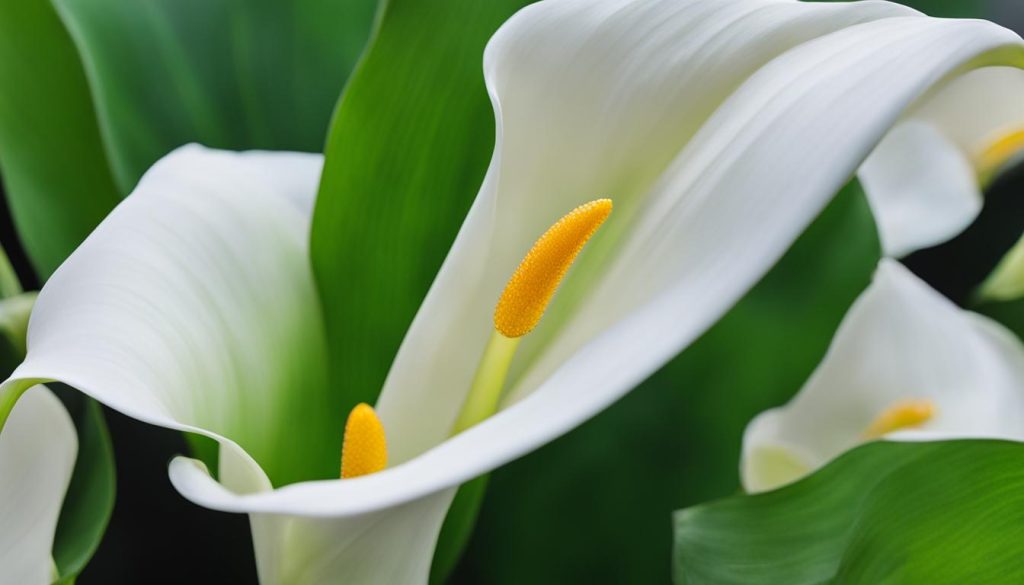Calla lilies are elegant and sophisticated statement plants that add a touch of glamour to any garden. They come in a wide range of vibrant colors and can provide weeks of colorful blooms during the spring or late summer. These tender perennials can also be grown as annuals in cooler regions. Calla lilies are easily cultivated from rhizomes and make a stunning addition to beds, borders, containers, and even as houseplants. They are relatively low maintenance and are resistant to most pests and diseases. In addition to their beauty in the garden, calla lilies are also popular for floral arrangements, especially the white varieties that are commonly used in wedding bouquets.
Contents
- 1 What is a Calla Lily?
- 2 Cultivation and History
- 3 How to Grow Calla Lilies
- 4 Managing Pests and Disease
- 5 Conclusion
- 6 FAQ
- 6.1 How do I plant calla lilies?
- 6.2 Where should I plant calla lilies?
- 6.3 Can I grow calla lilies indoors?
- 6.4 What pests and diseases should I watch out for?
- 6.5 How do I overwinter calla lilies?
- 6.6 How long do calla lilies bloom?
- 6.7 Can calla lilies be used in floral arrangements?
- 6.8 Are calla lilies toxic?
- 7 Source Links
Key Takeaways:
- Learn how to plant calla lilies and enjoy their vibrant blooms.
- Discover tips for successful calla lily growth.
- Care for calla lilies to ensure they thrive in your garden.
- Find out how to grow calla lilies both indoors and outdoors.
- Manage pests and diseases to keep your calla lilies healthy.
Calla lilies are a beautiful addition to any garden or home. By following the proper planting and care techniques, you can ensure that your calla lilies thrive and bring good luck into your life.
What is a Calla Lily?
Calla lilies, also known as arum or pig lilies, are not true lilies but belong to the Zantedeschia genus in the Araceae family. These clump-forming perennials are native to southern Africa and are known for their distinctive chalice-like flowers. The flowers consist of a modified leaf called a spathe, which is typically white or brightly colored, and a finger-like inflorescence called a spadix. The spadix produces small seed pods after flowering. Calla lilies have elongated, stemless leaves that come in a range of green shades, from sage to jade, and often feature delicate white spotting. It’s important to note that all parts of the calla lily plant contain insoluble crystals of calcium oxalate, which can cause irritation if ingested.
Calla lilies get their name from the Greek word “kallos,” which means beauty. Their elegant and graceful appearance, combined with their vibrant colors, make them a popular choice for gardens and floral arrangements. The chalice-like flowers of calla lilies symbolize purity, rebirth, and beauty, and they are often associated with weddings and other special occasions.
“Calla lilies are known for their distinctive chalice-like flowers.”
The Zantedeschia Genus
The Zantedeschia genus is comprised of about 28 species, including the well-known calla lily hybrids. These hybrids have been created through selective breeding and hybridization, resulting in a wide range of colors and variations. Some popular calla lily hybrid cultivars include ‘Red Alert,’ ‘Black Forest,’ and ‘Pink Mist.’ Each cultivar has its own unique characteristics and can add a touch of drama or romance to any garden or floral arrangement.
Foliage Colors
While calla lilies are most commonly known for their show-stopping flowers, their foliage also plays an important role in their overall appearance. The leaves of calla lilies can range from solid green to variegated, with contrasting patterns of white, yellow, or pink. The foliage colors add an additional layer of interest to the plant and can complement or contrast with the colors of the flowers. Whether you prefer a classic white calla lily with green foliage or a bold and vibrant variety with variegated leaves, there is a calla lily for every taste and style.
Table: Calla Lily Species
| Species | Common Name | Flower Color | Foliage Color |
|---|---|---|---|
| Zantedeschia aethiopica | White Calla Lily | White | Green |
| Zantedeschia rehmannii | Pink Calla Lily | Pink | Green |
| Zantedeschia elliottiana | Golden Calla Lily | Yellow | Green |
| Zantedeschia albomaculata | Spotted Calla Lily | White with Spots | Green with White Spots |
Table: Calla Lily Species
Cultivation and History
Calla lilies have a fascinating history and cultivation process. These stunning flowers have their origins in South Africa, where they grow naturally in tropical meadows and along river banks. It wasn’t until the 17th century that the white arum lily, known as Zantedeschia aethiopica, was introduced to Europe by Simon van der Stel, the first governor of the Dutch colony at the Cape of Good Hope.
Since its introduction, calla lilies have undergone extensive hybridization, resulting in the development of numerous colored varieties with outstanding colors and extended bloom times. Today, calla lilies are not only cultivated as ornamental plants but also for commercial cut flowers, making them a popular choice for both garden enthusiasts and florists.
| Key Points | Details |
|---|---|
| Origins | Natively found in South Africa |
| Introduction to Europe | Brought by Simon van der Stel in the 17th century |
| Hybridization | Resulted in numerous colored varieties with extended bloom times |
With their rich history and the diversity of hybrids available today, calla lilies continue to captivate gardeners and flower enthusiasts worldwide. Whether they are grown as a standalone statement plant or incorporated into floral arrangements, these elegant flowers never fail to add a touch of sophistication to any setting.
How to Grow Calla Lilies
Growing calla lilies is a rewarding experience that allows you to enjoy the beauty of these elegant flowers. Whether you choose to plant them outdoors or indoors, following the proper cultivation techniques will help your calla lilies thrive. Here are some essential tips on how to grow calla lilies successfully:
Planting Calla Lily Bulbs
Start by selecting healthy calla lily bulbs from a reputable nursery or garden center. Choose bulbs that are firm and plump, avoiding any that appear soft or damaged. Plant the bulbs in well-drained soil, about 3 inches deep and spaced a foot apart. If you’re planting them in containers, make sure the pots have drainage holes to prevent waterlogging.
Growing Tips
Calla lilies prefer a sunny to partly shaded location. They require at least 4-6 hours of direct sunlight each day. If you live in a hot climate, provide them with some shade during the hottest part of the day to prevent wilting. Water your calla lilies regularly, keeping the soil moist but not waterlogged. Avoid overwatering as it can cause the bulbs to rot. Applying a layer of mulch around the plants can help conserve moisture and suppress weed growth.
Care Guide
Regular fertilization is important for healthy calla lily growth. Use a balanced fertilizer with equal amounts of nitrogen, phosphorus, and potassium. Apply the fertilizer once a month during the growing season. Remove any faded blooms to encourage continuous flowering. After the first frost, if you live in a region with cold winters, dig up the bulbs and store them in a cool, dry place until the next planting season. By following these care guidelines, you can ensure your calla lilies thrive and produce beautiful blooms.

| Quick Reference Guide: How to Grow Calla Lilies |
|---|
| Choose healthy calla lily bulbs |
| Plant bulbs in well-drained soil, 3 inches deep and a foot apart |
| Provide a sunny to partly shaded location |
| Water regularly, keeping the soil moist but not waterlogged |
| Fertilize monthly with a balanced fertilizer |
| Remove faded blooms to encourage continuous flowering |
| Overwinter bulbs in cool, dry storage (if applicable) |
Managing Pests and Disease
While calla lilies are generally resistant to pests and diseases, it’s important to be aware of common problems and take preventative measures to ensure the health of your plants. Below are some of the pests and diseases that can affect calla lilies, along with tips for prevention and treatment:
Aphids
Aphids are small, soft-bodied insects that can be found on the leaves and stems of calla lilies. They suck sap from the plants, causing curling leaves and stunted growth. To prevent aphid infestations, regularly inspect your plants and remove any affected leaves. You can also introduce natural predators like ladybugs or use insecticidal soaps to control aphids.
Bacterial Soft Rot
Bacterial soft rot is a common disease that affects calla lilies, particularly in wet or humid conditions. It causes the plant tissue to become mushy and discolored. To prevent bacterial soft rot, make sure your plants are well-drained and avoid overwatering. If you notice any signs of soft rot, remove the affected plant parts and apply a copper-based fungicide to protect the remaining healthy tissue.
Botrytis
Botrytis, also known as gray mold, is a fungal disease that affects many plants, including calla lilies. It thrives in cool, humid conditions and can cause brown spots and fuzzy gray mold on the foliage and flowers. To prevent botrytis, provide good air circulation by spacing your plants properly and avoid overhead watering. If you notice any signs of gray mold, remove the affected plant parts and apply a fungicide labeled for botrytis control.
| Pests and Diseases | Symptoms | Prevention and Treatment |
|---|---|---|
| Aphids | Curling leaves, stunted growth | – Regular inspection and removal of affected leaves – Introduce natural predators or use insecticidal soaps |
| Bacterial Soft Rot | Mushy, discolored plant tissue | – Well-drained soil and avoiding overwatering – Removal of affected plant parts and application of copper-based fungicide |
| Botrytis | Brown spots, gray mold on foliage and flowers | – Good air circulation and avoiding overhead watering – Removal of affected plant parts and application of botrytis-specific fungicide |
By being proactive in managing pests and diseases, you can ensure the health and vitality of your calla lilies. Regular monitoring, proper care, and prompt action when necessary will help your plants thrive and continue to bring beauty to your garden or floral arrangements.

Conclusion
Planting and growing calla lilies can be a rewarding experience. These elegant and sophisticated plants not only add beauty to your garden or floral arrangements but also bring good luck into your life. By following expert advice for calla lily planting, you can ensure that your calla lilies thrive and flourish.
To create thriving calla lily plants, it’s important to choose a sunny to partly shaded location and provide well-drained soil. Regular care and maintenance, including watering and fertilizing, will help your calla lilies grow healthy and vibrant. Remember to protect them from intense afternoon sun and provide appropriate winter care if needed.
Whether you choose to grow calla lilies outdoors or indoors, these stunning flowers will add a touch of sophistication to your surroundings. With their vibrant colors and long bloom times, calla lilies are a versatile addition to any garden or home. Follow the expert advice shared in this guide, and enjoy the beauty of calla lilies for years to come.
FAQ
How do I plant calla lilies?
Plant calla lilies from rhizomes, 3 inches deep and about a foot apart. Provide regular watering and monthly fertilization for optimal growth.
Where should I plant calla lilies?
Calla lilies prefer a sunny to partly shaded location with well-drained, nutrient-rich soil.
Can I grow calla lilies indoors?
Yes, calla lilies can be grown indoors depending on your climate and personal preferences. Provide a sunny location and proper care for indoor growth.
What pests and diseases should I watch out for?
Common pests include aphids, spider mites, thrips, slugs, and whiteflies. Diseases to watch out for include bacterial soft rot and Botrytis, a fungal mold. Use appropriate insecticides or organic pest management techniques and practice good cultural practices to prevent and treat these issues.
How do I overwinter calla lilies?
If necessary, overwinter calla lilies by lifting the rhizomes, cutting back foliage, and storing in a cool, dry place for the winter months.
How long do calla lilies bloom?
Calla lilies can provide weeks of colorful blooms during the spring or late summer.
Can calla lilies be used in floral arrangements?
Yes, calla lilies are popular for floral arrangements, especially the white varieties commonly used in wedding bouquets.
Are calla lilies toxic?
Yes, all parts of the calla lily plant contain insoluble crystals of calcium oxalate, which can cause irritation if ingested. Keep calla lilies out of reach of pets and children.





